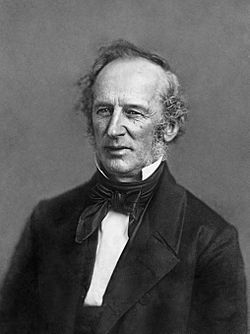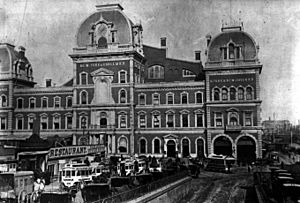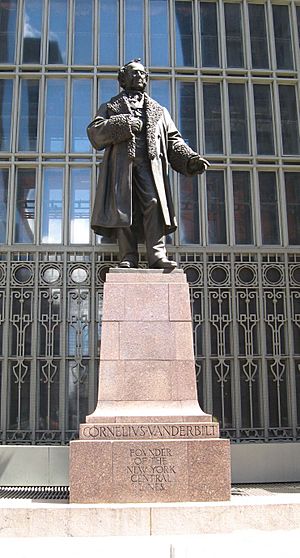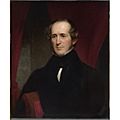Cornelius Vanderbilt facts for kids
Quick facts for kids
Cornelius Vanderbilt
|
|
|---|---|
 |
|
| Born | May 27, 1794 |
| Died | January 4, 1877 (aged 82) New York City, U.S.
|
| Occupation | Railroad/Water transport businessman, philanthropist |
| Spouse(s) |
|
| Children |
|
| Parent(s) |
|
| Relatives |
|
| Signature | |
Cornelius Vanderbilt (May 27, 1794 – January 4, 1877) was a very successful American businessman and generous giver. People often called him "Commodore Vanderbilt." He earned a huge fortune in shipping and railroads.
Born into a family with little money, he didn't get much schooling. But with hard work, smart ideas, and some luck, he became a leader in water transport. He then invested in the fast-growing railroad business. He is most famous for building the New York Central Railroad.
Cornelius Vanderbilt became one of the richest Americans ever. He was the head of the powerful and wealthy Vanderbilt family. He also gave the first money to start Vanderbilt University in Nashville, Tennessee.
Contents
Early Life and First Businesses
Cornelius Vanderbilt was born on Staten Island, New York. His parents were Cornelius van Derbilt and Phebe Hand. When he was a boy, he started working on his father's ferry boat in New York Harbor. He left school when he was only 11 years old.
At 16, Vanderbilt decided to start his own ferry service. He began by carrying goods and people between Staten Island and Manhattan. He was so energetic and eager in his work that other boat captains jokingly called him "The Commodore." This nickname stayed with him his whole life.
Some of the first railroads in the United States connected Boston to Long Island Sound. They were built to link up with steamboats that traveled to New York. By the end of the 1830s, Vanderbilt was in charge of most of the steamboat business on the Sound. He then started to manage the railroads that connected to his boats.
In the 1840s, he worked to take over the best of these railroad lines. This was the New York, Providence and Boston Railroad, also known as the Stonington. Vanderbilt lowered prices on competing lines. This made the Stonington's stock price drop, and he became its president in 1847. This was the first of many railroads he would lead.
During these years, Vanderbilt also ran many other businesses. He bought a lot of land in Manhattan and Staten Island. In 1838, he took over the Staten Island Ferry.
Vanderbilt and the Civil War
When the Civil War started in 1861, Vanderbilt wanted to help. He tried to give his largest steamship, the Vanderbilt, to the Union Navy. However, the Secretary of the Navy, Gideon Welles, said no. He thought the ship would be too costly to run for what he expected to be a short war.
Later, a Confederate ironclad ship called the Virginia caused a lot of damage. It attacked Union ships at Hampton Roads, Virginia. The Secretary of War, Edwin Stanton, and President Abraham Lincoln asked Vanderbilt for help. This time, he successfully gave the Vanderbilt to the Union navy. He even paid to equip it with a ram and chose its officers himself.
For giving the Vanderbilt, he received a special award called a Congressional Gold Medal. Vanderbilt also paid to prepare a large military trip to New Orleans. He faced a sad loss when his youngest son, George Washington Vanderbilt, became sick and died. George was his favorite son and was expected to take over his businesses. He died before ever fighting in the war.
Taking Control of Railroads
Even though Vanderbilt had left his role as president of the Stonington Railroad, he became interested in other railroads in the 1850s. He joined the boards of directors for several lines, including the Erie Railway and the New York and Harlem.
In 1863, Vanderbilt gained control of the Harlem railroad. He did this by buying up a lot of its stock. He was then chosen as its president. He later explained that he wanted to show that he could make this railroad, which many thought was worthless, very valuable.
Building a Railroad Empire
Once he was in charge of the Harlem railroad, Vanderbilt had disagreements with other connecting lines. In every case, Vanderbilt won these battles. He bought control of the Hudson River Railroad in 1864. Then he bought the New York Central Railroad in 1867. He also bought the Lake Shore and Michigan Southern Railway in 1869, and later the Canada Southern.
In 1870, he combined two of his main lines. These became the New York Central and Hudson River Railroad. This was one of the first very large companies in United States history.
Grand Central Depot
In 1869, Vanderbilt told the Harlem railroad to start building the Grand Central Depot. This was located on 42nd Street in Manhattan. It was finished in 1871. This building became the main station for his railroad lines in New York City.
He also had the tracks on 4th Avenue lowered into a ditch, which later became a tunnel. This change made 4th Avenue become Park Avenue. The Grand Central Depot was later replaced by the famous Grand Central Terminal in 1913.
Railroads Controlled by Vanderbilt
Here are some of the railroads Cornelius Vanderbilt controlled:
- New York and Harlem Railroad (from 1863)
- Hudson River Railroad (from 1864)
- New York Central Railroad (from 1868)
- Canada Southern Railway (from 1873)
- Lake Shore and Michigan Southern Railway (from 1873)
- Michigan Central Railroad (from 1877)
- New York, Chicago and St. Louis Railroad (Nickel Plate Road, from 1882)
- West Shore Railroad (from 1885)
Death and Lasting Impact
Cornelius Vanderbilt passed away on January 4, 1877. He was at his home in New York City. He had been ill for about eight months. He died from being very tired due to many long-term health problems. When he died at age 82, Vanderbilt's fortune was estimated to be $100 million.
Experts have tried to figure out how much his wealth would be worth today. Some say he would be the second-richest person in U.S. history. This is based on how much his wealth was compared to the country's total economy at the time. He is often ranked among the wealthiest people in history.
In 1999, Cornelius Vanderbilt was honored in the North America Railway Hall of Fame. This recognized his important contributions to the railroad industry. He was included in the "Railway Workers & Builders: North America" group.
Vanderbilt's Family
Cornelius Vanderbilt was buried in the family tomb at the Moravian Cemetery on Staten Island. Later, his son Billy built a new tomb in the same cemetery, and Cornelius was reburied there.
After his death, three of his daughters and his son, Cornelius Jeremiah Vanderbilt, argued about his will. They claimed their father was not in his right mind when he made the will. The court case lasted over a year. In the end, Billy won the case completely.
Some of his famous descendants today include his great-great-granddaughter Gloria Vanderbilt. She was a well-known fashion designer. Her youngest son is Anderson Cooper, a television news anchor. Another descendant, through Billy's daughter Emily Thorn Vanderbilt, is the actor Timothy Olyphant.
Images for kids
-
Grand Central Terminal in New York City, New York, in 2012.
-
The Vanderbilt family mausoleum at the Moravian Cemetery on Staten Island, where Cornelius is buried.
See also
 In Spanish: Cornelius Vanderbilt para niños
In Spanish: Cornelius Vanderbilt para niños











